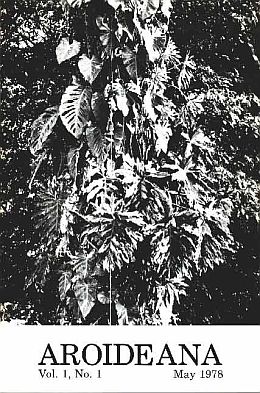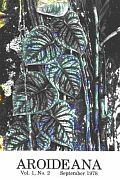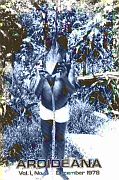|
|



Your search for articles published in volume 1 has found 19 articles.

|

| 
| 
|
Articles of 3 pages or less are available for free to IAS members for download, and longer articles for $5. Articles from issues in 2016 and beyond are only available electronically, and are free to current members when they are logged in.
Please remember that all Aroideana articles are protected by copyright, and you may NOT distribute even electronic copies without permission from the authors or editor.
(Issue) |
||||
| Michael Madison | Introductory remarks
This article available FREE to IAS Members with a PERSONAL login. LOGIN, REGISTER or JOIN | |||
| ABSTRACT: The family Araceae includes some 2000 species of perennial herbs mostly native to wet tropical areas, but also represented in temperate and semi-arid regions. The family is not especially closely related to any other plant family, but evidently diverged from the other flowering plants at an early stage and has had a long and independent evolution. | ||||
| Simon J. Mayo | Aroid-hunting in Bahai (Buy) | |||
| ABSTRACT: Despite having been the first area of Brazil to be colonized by the Portuguese, the north-eastern state of Bahia is still poorly-known botanically, particularly in its dry interior region. All the indications are, however, that the flora is very rich, and this applies to the aroids as well as to many other families of plants. Consequently, when in the first three months of 1977 I took part in a Kew expedition to Bahia led by Dr. Raymond Harley, I was particularly keen to refind the many poorly-known Araceae recorded from this region. | ||||
| Michael Madison | On the names of aroids
This article available FREE to IAS Members with a PERSONAL login. LOGIN, REGISTER or JOIN | |||
| ABSTRACT: It would seem useful in this first issue to clarify some aspects of the naming of plants. The latin name of a plant species consists, technically, of three parts which appear in the following order: first the genus, which is capitalized, ego Philodendron; followed by the species, which is not capitalized, ego giganteum; followed by the name of the person who first described the species, in this case H. W. Schott. So the name of this West Indian species is Philodendron giganteum Schott. In orticultural literature the author's name is often omitted. | ||||
| Michael Madison | Philodendron frits-wentii rediscovered
This article available FREE to IAS Members with a PERSONAL login. LOGIN, REGISTER or JOIN | |||
| ABSTRACT: Recently Timothy Plowman of Harvard University and Helen Kennedy of the Field Museum discovered Philodendron frits-wentii in the wild in Peru, and sent cuttings to the Marie Selby Botanical Gardens where it is now cultivated. The exact locality, in the Dept. of San Martin, is about 500 km from the nearest known station for P. grazielae. | ||||
| Michael Madison | Aroid profile no. 1: Monstera deliciosa
This article available FREE to IAS Members with a PERSONAL login. LOGIN, REGISTER or JOIN | |||
| ABSTRACT: It is appropriate that the first of this series of aroid profiles should depict what is probably the finest foliage plant ever introduced into horticulture - Monstera deliciosa. Well known as a house plant in temperate regions, the species is at its most magnificent out of doors as a rambling vine or climber in tropical localities. Under the best circumstances the leaves are a meter in length with a thick glossy texture and more than a hundred of their characteristic perforations. | ||||
| Michael Madison | The Anthurium leuconeurum confusion
This article available FREE to IAS Members with a PERSONAL login. LOGIN, REGISTER or JOIN | |||
| ABSTRACT: There are several species of Anthurium with velvety deep green leaves and silver veins which have been for years among the most prized subjects of aroid collections. Recently large numbers of these plants have become available in the nursery trade, with wholesalers supplying plants either by massive collections from the wild or by growing plants from seed, much of the latter taking place in Costa Rica. Most of the plants in the trade are distributed as Anthurium clarinervium or A. crystallinum, but there seems to be no general agreement as to which is which. The following notes should help to clarify the situation. | ||||
| Anonymous | First Prize in the Miami show
This article available FREE to IAS Members with a PERSONAL login. LOGIN, REGISTER or JOIN | |||
| ABSTRACT: The International Aroid Society was awarded first place in the Educational Exhibit Section at the Metropolitan Miami Flower Show last month. | ||||
| Simon J. Mayo | The aroid collection of Roberto Burle-Marx
This article available FREE to IAS Members with a PERSONAL login. LOGIN, REGISTER or JOIN | |||
| ABSTRACT: The estate of Roberto BurleMarx is near Guaratiba to the southwest of Rio de Janeiro, beyond the Serra da Pedra Branca and the Restinga da Jacarepagua, and occupies a site stretching from the top of a fairly steeply-sloping hillside to its base. The principal botanical interest of his plant collection, which he has amassed over some 30 years or so, lies in the very rich collections of Araceae, Bromeliaceae, Musaceae, Velloziaceae and Orchidaceae. As regards the Araceae, his collections of Anthurium and Philodendron spp. merit special attention, being not only of Brazilian species but also with good representation from Ecuador, Costa Rica, Panama and other parts of the neotropics in which Sr. Burle-Marx has collected. | ||||
| Michael Madison | A new species of Xanthosoma from Ecuador
This article available FREE to IAS Members with a PERSONAL login. LOGIN, REGISTER or JOIN | |||
| ABSTRACT: Xanthosoma weeksii Madison, sp. nov. is described. | ||||
| Michael Madison | Aroid literature: The Aroids of Mexico
This article available FREE to IAS Members with a PERSONAL login. LOGIN, REGISTER or JOIN | |||
| ABSTRACT: Bunting. G.S. 1965. Commentary on Mexican Araceae. Gentes Herbarum 9:290-382. Matuda, E. 1954. Las Araceas Mexicanas. An. lnst. BioI. 25:97-218. These two works are the basic references on the aroid flora of Mexico, which includes close to a hundred species mostly native to the humid gulf coast and southwestern parts of the country. A number of the species are fine ornamentals well-known in cultivation | ||||
| Thomas B. Croat | Dr. Eizi Matuda
This article available FREE to IAS Members with a PERSONAL login. LOGIN, REGISTER or JOIN | |||
| ABSTRACT: The world of aroid lovers mourns the death of Dr. Eizi Matuda, Senior Curator of the Instituto de Biologia at the Universidad Nacional Autonoma de Mexico in Mexico City. Dr. Matuda, a long time expert in Araceae died February 12, in Peru, while on a field trip following the Second Latin American Botanical Congress in Rio de Janeiro. | ||||
| Michael Madison | The genera of Araceae in the northern Andes (Buy) | |||
| ABSTRACT: The north Andean region, which includes Colombia, Ecuador, and Peru, has perhaps the richest flora in the world and is the center of diversity of the family Araceae. The low to middle elevation wet forests of the area abound with aroids which cover the ground, climb up tree trunks, and as epiphytes adorn the outer branches of the trees. Many of our finest ornamental aroids, including Anthurium andreanum, A. crystallinum, Caladium bicolor, and Philodendron erubescens, are derived from this area. The purpose of this paper is to provide a key and brief descriptions of the genera of Araceae of the northern Andes which should enable anyone to identify to genus aroids from the region. The key is also applicable in Central America, but only partly so in the rest of South America where a number of additional genera, principally of the subfamily Aroideae, are found. | ||||
| Thomas B. Croat | A new Anthurium from Panama (Buy) | |||
| ABSTRACT: Anthurium dressleri sp. nov. is described. | ||||
| Michael Madison | Potting media for epiphytic aroids
This article available FREE to IAS Members with a PERSONAL login. LOGIN, REGISTER or JOIN | |||
| ABSTRACT: A well-known principle of horticulture is that to grow a plant well you should try to duplicate as closely as possible the conditions under which it thrives in the wild. Since the family Araceae encompasses genera and species from widely varying habitats, including epiphytes, terrestrials, aquatics, and vines, it is evident that no single potting medium will serve equally well for all of the species. Nonetheless, a good number of the aroids in cultivation are epiphytes which have roughly similar requirements and can be grown in a standard soil mix. | ||||
| Anonymous | Photograph: Dr. Eizi Matuda (1894-1978)
This article available FREE to IAS Members with a PERSONAL login. LOGIN, REGISTER or JOIN | |||
| ABSTRACT: Photograph: Dr. Eizi Matuda (1894-1978), authority on the Araceae of Mexico, with Tillandsia superinsignis | ||||
| Josef Bogner | A critical list of the aroid genera (Buy) | |||
| ABSTRACT: Engler's system of the aroids, over one hundred years old, is based not only on floral structures, but also uses vegetative and anatomical characters. His system is still viable and no large changes are necessary today. His arrangement shows a natural phylogenetic system and it has been accepted by all serious students of the family (M. R. Birdsey, G. S. Bunting, T. Croat, M. Madison, D. H. Nicolson, M. Hotta (with a few modifications). | ||||
| Michael Madison | The aroid collections at the Marie Selby Botanical Gardens
This article available FREE to IAS Members with a PERSONAL login. LOGIN, REGISTER or JOIN | |||
| ABSTRACT: The collection of living aroids at Selby, still actively increasing, at present includes over 1100 collections representing about 600 species in 44 genera. Nearly all are wildcollected plants with carefully kept records of their place of origin, identifiable from an accession number embossed in an aluminum tag 74 attached to each plant. The best represented genera are Anthurium (400+ collections), Philodendron (166 collections) and Caladium (28 collections). The bulk of the collection has been assembled by three of the Gardens' staff members: Dr. Calaway H. Dodson, DIrector; Dr. M. T. Madison, Curator, and Dr. Timothy Plowman, Adjunct Taxonomist. Since these three have research interests centered in the northern Andes, it is not surprising that plants from Ecuador, Colombia, and Peru predominate in the collection. The representation of Asian aroids is much weaker, and from Africa and Australia there is hardly anything at all. | ||||
| Harald Riedl | Heinrich Wilhelm Schott as a developmental morphologist (Buy) | |||
| ABSTRACT: Heinrich Wilhelm Schott is well known as the first important monographer of the family of Araceae who also had proposed a great number of generic names still in use in this family. In numerous publications ranging from short notes covering less than one page to magnificently illustrated volumes in quarto and the voluminous Prodromus systematis Aroidearum he contributed more to our knowledge of aroids than any other botanist with perhaps the exception of A. Engler. | ||||
| Michael Madison | Aroid profile no. 2: Anthurium lilacinum
This article available FREE to IAS Members with a PERSONAL login. LOGIN, REGISTER or JOIN | |||
| ABSTRACT: Anthurium lilacinum Dressler, Selbyana 2:300 (1978). Etymology: From the Greek anthas 'flower,' and aura, 'tail,' referring to the resemblance of an anthurium inflorescence to the tail of a mouse· and Latin lilacinus, 'lilac-colored; referring to the spathe and spadi~. | ||||
All Images and Text © 1996 to 2025 by the International Aroid Society or by their respective owners as noted.
Please send your comments to
served by aws-web2
